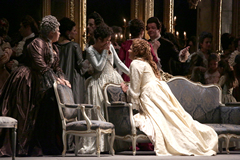| Opera Reviews | 19 April 2024 |
Netrebko, Eyvazov and Salsi bring star power to Andrea Chénierby Silvia Luraghi |
|
| Giordano: Andrea Chénier Teatro alla Scala, Milan 12 December 2017 |
|
|
Strange as it may sound, Giordano’s opera had not been shown on the Milanese stage since 1985, when Chailly conducted a revival of the 1982 production, which also featured him in the pit. In fact, in spite of having had its world premiere at La Scala, Andrea Chénier has not been frequently performed at the theatre, and has suffered the misfortune of other operas of its time. Chailly’s predecessor with this opera had been Gianadrea Gavazzeni, a renowned verismo advocate, in 1960. Now, Chailly has vowed to bring back this important part of the Italian repertoire to La Scala, and indeed last season featured a lesser know Giordano work, La cena delle beffe and the current one will offer Zandonai’s Francesca da Rimini. Andrea Chénier is a popular opera in comparison, and the stellar cast contributed to the quick and quite satisfactory ticket sale. Diva Anna Netrebko, at her second opening night at La Scala, lent her luxurious soprano to Maddalena di Coigny. Her beautifully timbred and perfectly tuned voice shows a ringing top and easily fills the house with its volume. The singer was very compelling in the dramatic parts of the opera, after the first act. In the first act, one missed a little bit the light, joyful sound of a carefree young woman, and even in the following acts some low notes in the love duets sounded somewhat too dark. Baritone Luca Salsi was an outstanding Carlo Gérard, always tasteful in a role that can easily become vulgar. His aria ‘Nemico della patria’ can easily be regarded as the highlight of the performance. The real surprise of the production though was tenor Yusif Eyvazov in the title role. The appearance of the singer, who is Netrebko’s husband, had been preceded by discussions on his suitability for the role, and a major disaster had been anticipated, such as to convince the conductor to perform the opera without allowing the slightest possibility for reaction from the audience during the performance. At opening night, the singers only came to the stage together to receive the applause, and there were still some boos from the most hardened of the loggionisti. This was Eyvazov’s role and company debut and it came on an opening night - perhaps too much to handle in one time. However, the tenor managed to capture the audience’s sympathy, and ended his performance with honors. True, his voice is not the most handsome tenor voice one has ever heard, and he still has to work on the volume, especially if he plans to sing frequently with Netrebko. But he had prepared very carefully, and proved to be technically very skilled especially in managing some effective piani. At the second performance, when the atmosphere had become more relaxed, the singers finally came to the stage one by one after the curtain fell, and Eyvazov was able to receive his deserved tribute of applause. All the smaller roles were very well covered, with well etched performances from Mariana Pentcheva as Contessa di Coigny, Gabriele Sagona as Rocher, Judit Kutasi as Madelon and Carlo Bosi as Incredibile. Also very well prepared was the chorus, which actively contributed to the success of the performance. The new production was directed by Mario Martone, in collaboration with set designer Margherita Palli and costume designer Ursula Patzak. It set the action in its historical time and was visually quite traditional. A turning set was functional to the conductor’s choice of having only one intermission between the second and the third act, with no breaks in the music elsewhere. In the first act, the interior of Coigny’s palace was backed by large mirrors, which at times turned into window panes, from which the poor looked inside at the nobility. The staged turned on the last notes of the shepherds’ song, and showed the streets of Paris occupied by the revolutionaries waving the republican flag. In the third act Chénier meets Maddalena in the slums, where he fights with Gérard and wounds him. The action then moves to Gérard’s home, where he writes his accusation and receives Maddalena. The two of them are then off to the revolutionary tribunal, where Chénier is sentenced to death. In the fourth act, Maddalena meets Chénier in his cell, while the executioner prepares the guillotine outside. While the sets and costumes certainly helped with the rendering of Giordano’s vision, the stage directions left much to be desired. In fact, one had the impression that the singers had been left without direction, as they virtually only stood on stage and sang without much attempt at some dramatic rendering of the action. On the other hand, the musical side was extremely well crafted. Maestro Chailly, an expert of this score, had carefully prepared every single musician in the orchestra, creating a powerful yet tuneful account of the score. The house was packed, and the audience left the performance after ten minutes’ applause visibly happy with what they had seen and heard.
|
|
| Text ©
Silvia Luraghi Photo © Teatro alla Scala |

 For this year’s December 7th Gala at La Scala Maestro Riccardo Chailly chose Umberto Giordano’s Andrea Chénier, his third opening night for the company.
For this year’s December 7th Gala at La Scala Maestro Riccardo Chailly chose Umberto Giordano’s Andrea Chénier, his third opening night for the company.





